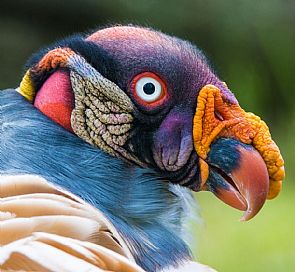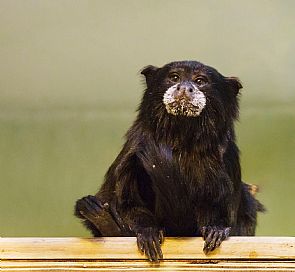Flora and Fauna: Chile's wildlife Guide
Wildlife observation consists on observing the natural flora and fauna of an area with recreational, educational or research aims. In Chile, it is a very common and highly valued activity, given its biodiversity.
Birds

From the North to the South, from the sea to the mountains, you can find 439 species of birds in Chile. Of these, 296 nest and live here while the others are habitual or occasional…
Flora

Thanks to our diverse geography and climate, Chile offers a wide variety of flora species. In the Northern coast, the vegetation is nearly non-existant, except for a large variety of…
Land Animals

The Chilean fauna is as varied as the flora, though less abundant. In the mammalian group, the species which stand out are the puma, an American savage cat; guanaco, a South American…
The Chilean Flora and Fauna
Chile has a less diverse fauna and flora than some other countries, yet it's particularly interesting due to its high percentage of endemic species. This has made our ecosystem quite vulnerable to change and intervention, be it human or animal, thus threatening the existence of several species.
To control these threats, Chile has a network of parks and natural reserves that protect a representative set of ecosystems that exist throughout the country. These protected areas are administrated by the National Forest Service (CONAF), which manages and protects these zones so as to improve their development.
In the North of Chile, fauna is determined by two very distinct ecosystems. On the one hand, the Atacama Desert - the driest in the world - limits both the amount and variety of species. However, at an altitude of more than 3,500 meters (11,480 ft), the influence of the Bolivian tropical climate produces a particular environment. It is characterized by strong rains in summer and rich, low altitude vegetation that allows the existence of numerous animal species. This is precisely what happens in Lauca National Park, located in the first region, where almost a third of all the bird species that exist in Chile can be found. Perhaps, the most remarkable of these birds is the Andean Flamingo, the biggest of the three species of flamingo living in the North.
A greater variety of animals can be found in the Central Valley. The reason is very simple: here, the climate conditions are better with temperatures rarely falling below 0ºC. The most common animals found in this area are mice, foxes and other small mammals. Pumas still roam in several national parks.
There is also a rich variety of birds in this zone. Near Santiago, there are many habitats for birds such as the Crag Chilia or Chiricoca, Moustached Turca, Diademed Sandpiper-plover, Black-fronted Ground-tyrant and the Grey-flanked Cinclodes.
In spite of having a harsher wheather, the South features a fascinating fauna. In the forests, for example, there are two species of deer: the small pudú, which is found in Puerto Montt, Chiloé and Valdivia, and the huemul, in Chiloé, Aysén and Magallanes.
In Patagonia, guanacos, foxes, pumas and ñandúes roam free (ñandu is a native South American bird similar to the ostrich, but smaller). Along with the Chilean flamingo, the ñandu is among the most easily observed.
Moreover, the sea fauna in Southern Chile and the Far South is magnificent. But possibly the most remarkable mammals are the whales, who meet in the Antarctica to feed on krill and, when the temperatures drop, they head North to mate in tropical seas.
Destinations
The places that best represent the flora and fauna of a region are mainly our national parks, reserves, and monuments. Here are some of the most important ones:
Big North
- Lauca National Park
- Pan de Azúcar National Park
Small North
- Fray Jorge National Park
Central Valley
- La Campana National Park
- Rapa Nui National Park
- Juan Fernández Archipelago National Park
- Los Cipreses National Reserve
- Radal 7 Tazas National Reserve
- Altos de Lircay National Reserve
- Torca Lagoon National Reserve
Araucanía and Lakes District
- Laguna del Laja National Park
- Huerquehue National Park
- Tolhuaca National Park
- Conguillio National Park
- Puyehue National Park
- Vicente Pérez Rosales National Park
Northern Patagonia
- San Rafael Lagoon National Park
- Queulat National Park
Southern Patagonia
- Torres Del Paine National Park
- Milodon Cave Natural Monument
More information about Flora and Fauna destinations
GoChile Blog:
- San Pedro de Atacama: The Desert's Entrance Door
- Torres del Paine: All You Need to Know
- Life in the Chilean Flowering Desert
- Villa O'Higgins: Patagonia's Paradise Lost
- Puerto Guadal and Lake General Carrera
- Navarino Island: An Experience at the World's End
- Cochamó Valley: A New Path in the Horizon
- About Huilo Huilo: Conservation and Tourism
- The Trails of Quinquén
Other Related Articles:
- Río de los Cipreses National Reserve: Ecoturism in The O'Higgins Region
- La Campana National Park: The Last Refuge of the Chilean Palm Tree
- Monumento Natural El Morado: Cerca del Santiago y del Cielo
- Altos del Lircay Natural Reserve: Between Forests and Hills
Recommendations
Many of our native species, both in the animal and plant kingdoms, are in serious danger of extinction. In order to reverse this decline, it is fundamental to respect habitats and species. When you visit a protected area, respect the delicate balance of the ecosystem and avoid interfering with it. In cases where it is inevitable, please try to minimize risks and impacts.
In Chile, there are no species that pose great danger to human beings, like snakes or poisonous insects. The only possible exception is the puma, the only great cat from these latitudes. However, he usually avoids contact with people, therefore it's very difficult to observe in its natural environment.
Ecology
- Be respectful of nature.
- Do not dump garbage. If you brought it with you, take it with you. If you can, dispose properly of any litter you find.
- Build fires only in designated places.
- Do not collect flora and fauna specimens.
- Whenever it is possible, stay only on marked trails.
- Do not paint or mark on stones and trees. Nobody needs to know you were there.
- If you need to go to the toilet, dig a hole of 25 cm (10 inches) deep and cover it completely. This must be done least 30 m (100 feet) away from any water source (rivers, lakes, ponds).
- Try not to leave traces of your visit. This will allow everyone to enjoy such places in their best condition.
For more information check our blog article: Seven Principles of Leave No Trace: Ecotourism and Nature in Valdivia
Equipment
For wildlife watching you do not need lots of equipment. Nevertheless, there are things you must not forget:
- Clothes that are not too flashy.
- Binoculars.
- Camera.
- First aid kit.
- Hat and sunscreen lotion. Prolonged exposure to sunlight can be risky.
GoTips
Organizations
- Corporación Nacional Forestal (Conaf)
259 Bulnes Ave.
Office 604
Santiago
Phone (56-2) 696 66 77 - Comité Nacional Pro Defensa de la Flora y Fauna (Codeff)
- Fundación Terram
Website with articles on environment, pollution and natural resources, among others. It's goal is to create a sustainable development proposal in the country. - Pumalín Park
Information about the biggest private park in the world, services, features and project's aims.
Websites
- Chilean Birds
Website on Chilean birds, with pictures, sounds, species descriptions, places to watch and much more. - Chile Bosque
Diffusion project of Chilean forests' native flora species. - Unión de Ornitólogos de Chile
Organization dedicated to the preservation and protection of birds and their environments. - Chile Silvestre
Wild life photography
Books
- A Wildlife Guide to Chile: Continental Chile, Chilean Antarctica, Easter Island, Juan Fernandez Archipelago
Author: Sharon Chester
2008
